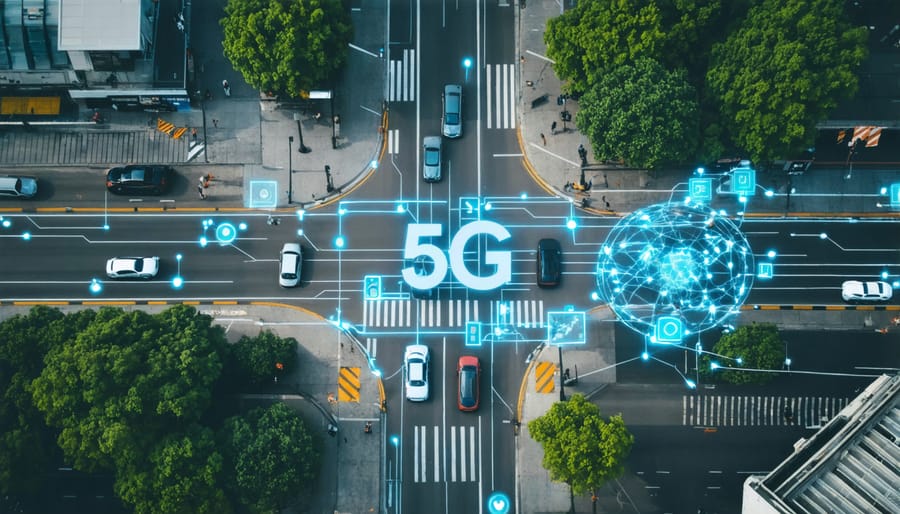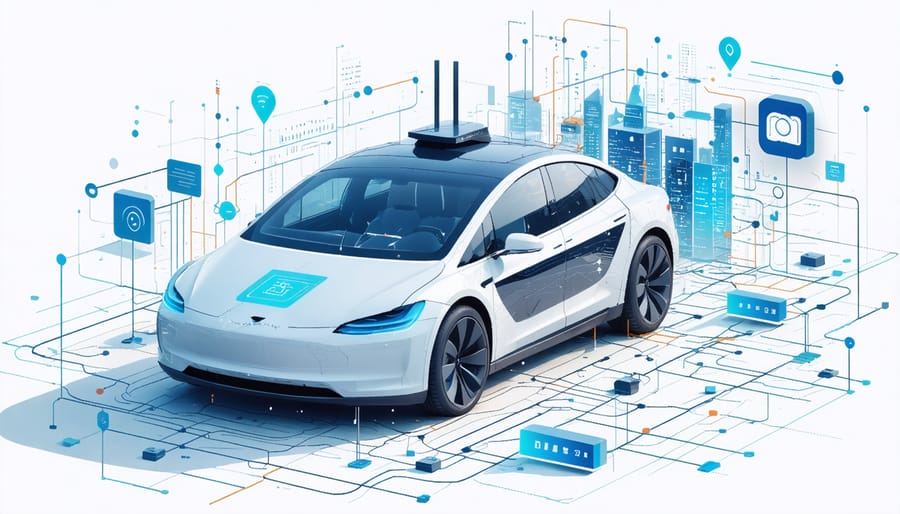The convergence of 5G technology and urban infrastructure is revolutionizing how modern cities operate, enabling unprecedented levels of connectivity and automation across smart urban mobility solutions and essential services. With data transmission speeds up to 100 times faster than 4G networks, 5G infrastructure serves as the backbone for real-time decision-making in traffic management, emergency response, and public utilities. This transformative technology supports up to one million connected devices per square kilometer, enabling seamless integration of IoT sensors, autonomous vehicles, and smart grid systems across urban landscapes.
Construction professionals and urban planners are witnessing a paradigm shift in infrastructure development, where 5G networks facilitate predictive maintenance, remote operations, and advanced building automation systems. Cities like Singapore, Barcelona, and Seoul demonstrate how strategic 5G implementation creates safer, more efficient urban environments through intelligent transportation systems, automated waste management, and responsive energy distribution networks. As we advance toward fully connected urban ecosystems, 5G technology stands as the critical enabler for sustainable, resilient smart cities that adapt in real-time to citizens’ needs.
The 5G Foundation of Smart Urban Transport

Ultra-Low Latency and Real-Time Response
In the realm of smart city transportation, 5G’s ultra-low latency capabilities represent a transformative leap forward. With response times as low as 1 millisecond, compared to 4G’s 20-30 milliseconds, this technology enables near-instantaneous communication critical for advanced mobility systems. These specifications, while meeting essential digital infrastructure requirements, create the foundation for real-time traffic management and autonomous vehicle operations.
The technical architecture supporting this performance relies on network slicing and edge computing implementations. By processing data closer to its source, edge computing reduces the physical distance information must travel, while network slicing ensures dedicated bandwidth for critical transportation applications. This combination delivers consistent, reliable performance essential for safety-critical systems.
In practical applications, this translates to intelligent traffic signals that can adjust timing within microseconds based on real-time traffic flow, emergency vehicle priority systems that respond instantaneously, and connected vehicles that communicate their position and trajectory with unprecedented precision. For construction professionals implementing these systems, understanding these capabilities is crucial for proper infrastructure planning and deployment.
The impact on urban mobility is particularly significant when considering V2X (Vehicle-to-Everything) communications, where milliseconds can make the difference in accident prevention and traffic flow optimization. This level of responsiveness ensures that smart transportation systems can operate with the reliability and safety margins necessary for widespread adoption.
Network Slicing for Priority Services
Network slicing represents a groundbreaking capability in 5G infrastructure, enabling cities to allocate dedicated bandwidth for critical transportation services. This technology allows network operators to create virtually segregated networks within the same physical infrastructure, ensuring priority services receive guaranteed performance levels regardless of overall network congestion.
In smart city applications, network slicing proves particularly valuable for emergency response vehicles, public transit systems, and traffic management operations. For instance, a dedicated network slice can ensure that emergency vehicles maintain uninterrupted communication with traffic control systems, automatically triggering green light sequences during critical responses.
The implementation typically involves three primary slicing configurations: enhanced Mobile Broadband (eMBB) for high-bandwidth applications, Ultra-Reliable Low-Latency Communications (URLLC) for critical real-time operations, and massive Machine-Type Communications (mMTC) for widespread IoT device networks.
Cities like Barcelona and Singapore have successfully deployed network slicing to prioritize their intelligent transport systems. Barcelona’s implementation allows real-time monitoring of bus fleet operations while maintaining dedicated bandwidth for emergency services. Similarly, Singapore utilizes network slicing to ensure reliable connectivity for its autonomous vehicle trials and smart traffic management systems.
This strategic bandwidth allocation not only improves service reliability but also enhances public safety and operational efficiency across urban mobility networks. The technology’s ability to dynamically adjust resource allocation based on real-time demands makes it an essential component of modern smart city infrastructure.
Smart Mobility Applications in Action
Autonomous Vehicle Integration
The integration of autonomous vehicles into smart city infrastructure represents a critical advancement enabled by 5G technology. With ultra-low latency and high-bandwidth connectivity, 5G networks provide the essential foundation for safe and efficient autonomous vehicle operations in urban environments.
Vehicle-to-Everything (V2X) communication systems, powered by 5G, enable real-time data exchange between vehicles, infrastructure, and pedestrians. This connectivity ensures autonomous vehicles can respond instantly to changing traffic conditions, emergency situations, and unexpected obstacles, maintaining safety standards while optimizing traffic flow.
Infrastructure requirements for autonomous vehicle integration include smart traffic signals, roadside units (RSUs), and sensor networks. These components work in concert to create a comprehensive traffic management system. High-density 5G small cells deployed along major corridors ensure consistent coverage, while edge computing facilities process critical data locally to minimize response times.
According to recent pilot programs in Singapore and Stockholm, cities implementing 5G-enabled autonomous vehicle systems have reported up to 30% reduction in traffic congestion and a 40% decrease in accident rates. These improvements stem from the enhanced precision in vehicle coordination and real-time routing optimization.
Key infrastructure considerations include:
– Strategic placement of 5G nodes along transportation corridors
– Integration of AI-powered traffic management systems
– Installation of smart sensors at intersections and pedestrian crossings
– Deployment of dedicated short-range communication (DSRC) units
– Implementation of robust cybersecurity measures to protect vehicle networks
These systems require careful planning and coordination between city planners, telecommunications providers, and transportation authorities to ensure seamless integration and optimal performance.

Intelligent Traffic Management Systems
5G technology is revolutionizing urban traffic management through advanced intelligent transportation systems that leverage real-time data processing and ultra-low latency communications. These systems integrate various components including smart traffic signals, connected vehicles, and AI-powered analytics to optimize traffic flow and reduce congestion.
Modern traffic management platforms utilize 5G networks to process data from thousands of IoT sensors, cameras, and connected vehicles simultaneously. This enables precise traffic prediction, dynamic signal timing adjustments, and automated incident detection. For example, in Barcelona’s 5G corridor project, smart intersections equipped with edge computing capabilities reduce average wait times by 25% during peak hours.
The implementation of vehicle-to-everything (V2X) communication through 5G enables real-time coordination between vehicles, infrastructure, and traffic control centers. This creates a responsive ecosystem where traffic patterns can be adjusted instantaneously based on current conditions. Emergency vehicle preemption becomes more efficient, with response times improved by up to 40% in pilot programs.
Key features include:
– Millisecond-level response times for critical safety applications
– AI-driven predictive analytics for proactive congestion management
– Integration with autonomous vehicle systems
– Real-time routing optimization for public transit
– Advanced pedestrian safety systems with immediate threat detection
These solutions not only improve traffic flow but also contribute to reduced emissions and enhanced road safety in urban environments.
Connected Public Transportation
5G technology is revolutionizing public transportation systems by enabling real-time connectivity and intelligent operations across transit networks. Transit authorities are implementing advanced IoT sensors and smart infrastructure to create seamless, efficient mobility solutions that enhance the passenger experience while optimizing operational efficiency.
Real-time vehicle tracking systems powered by 5G networks provide accurate arrival predictions and dynamic route optimization. Passengers receive instant updates through mobile apps, while transit operators can adjust schedules and deploy vehicles based on current demand patterns. This responsive system reduces wait times and improves service reliability.
Smart buses and trains equipped with 5G-enabled sensors monitor vehicle health, occupancy levels, and environmental conditions. These connected vehicles communicate with traffic management systems to receive priority at intersections, reducing journey times and fuel consumption. Predictive maintenance algorithms analyze sensor data to prevent breakdowns and optimize maintenance schedules.
Enhanced passenger amenities include automated fare collection, smart ticketing systems, and high-speed Wi-Fi connectivity throughout the journey. Digital information displays at stations and stops provide real-time updates, while smart surveillance systems ensure passenger safety and security.
Several cities have reported significant improvements after implementing 5G-enabled transit solutions. For example, Barcelona’s smart bus network achieved a 15% reduction in journey times and a 25% increase in passenger satisfaction. Similarly, Singapore’s connected transportation initiative has demonstrated how 5G technology can support sustainable urban mobility while improving operational efficiency.
Infrastructure Requirements and Implementation
Physical Infrastructure Integration
The integration of 5G infrastructure into existing urban environments requires careful planning and strategic deployment of physical components. Small cell installations, typically measuring 2-3 cubic feet, need to be positioned every 250-500 meters to ensure optimal coverage. These units are primarily mounted on existing street furniture, such as light poles, traffic signals, and building facades, minimizing additional structural requirements.
Critical infrastructure components include fiber optic backhaul networks, power distribution systems, and climate-controlled equipment cabinets. Municipal authorities must coordinate with telecom providers to establish standardized mounting specifications and ensure compliance with local building codes. Load-bearing calculations for existing structures become essential, as each small cell installation adds approximately 35-50 pounds of equipment.
Underground infrastructure modifications often become necessary, requiring strategic trenching for fiber optic cables and power lines. Construction teams must navigate existing utility networks while maintaining minimum separation distances between different service lines. Weather-resistant enclosures protect sensitive equipment, while proper ventilation systems prevent overheating.
Urban planners must consider aesthetic impact through camouflaging techniques and strategic placement. Many cities now mandate design guidelines that require 5G equipment to blend with historical architecture and streetscape elements. Power requirements typically range from 2-4 kW per installation, necessitating careful integration with existing electrical infrastructure.
Maintenance access points and service corridors must be incorporated into the design phase, ensuring technicians can safely perform routine maintenance and emergency repairs. This often requires the installation of secure access panels and dedicated climbing infrastructure on poles and buildings, meeting both safety regulations and operational needs.

Cybersecurity and Data Management
As 5G smart cities collect and process vast amounts of sensitive data, implementing robust infrastructure security measures becomes paramount. The cybersecurity framework for 5G-enabled urban environments must address multiple layers of protection, from network infrastructure to end-user devices.
Key security protocols include end-to-end encryption, network slicing for isolated security domains, and advanced authentication mechanisms. These measures ensure that critical systems—such as traffic management, emergency services, and utility networks—remain protected from cyber threats while maintaining operational efficiency.
Data management in 5G smart cities follows strict governance frameworks that comply with international standards and privacy regulations. Real-time monitoring systems employ AI-powered threat detection, while blockchain technology ensures data integrity and transparent audit trails. Cities like Singapore and Barcelona have implemented comprehensive security operations centers (SOCs) that continuously monitor network activity and respond to potential threats.
The integration of zero-trust architecture principles provides an additional security layer, requiring verification for every system access attempt, regardless of location or network position. This approach is particularly crucial for protecting sensitive infrastructure control systems and citizen data.
To maintain data sovereignty and privacy, smart cities are adopting edge computing solutions that process sensitive information locally before transmission. This distributed approach not only enhances security but also improves system response times and reduces bandwidth requirements. Regular security audits, penetration testing, and incident response drills ensure that protective measures remain effective against evolving cyber threats.
The integration of 5G technology in urban mobility systems represents a transformative leap forward in how cities operate and serve their residents. As demonstrated through numerous successful implementations worldwide, 5G’s ultra-low latency and massive device connectivity capabilities have proven instrumental in revolutionizing transportation infrastructure and enabling more efficient, safer urban environments.
The impact of 5G on urban mobility extends far beyond simple connectivity improvements. Real-time traffic management systems powered by 5G networks have shown reduction in congestion by up to 30% in pilot cities, while connected vehicle systems have demonstrated significant improvements in road safety metrics. The ability to process and analyze vast amounts of data in real-time has enabled predictive maintenance of transportation infrastructure, resulting in cost savings and improved service reliability.
Looking ahead, the trajectory of 5G-enabled smart city development appears increasingly promising. Industry experts project that by 2025, over 85% of major urban centers will have implemented some form of 5G-based mobility solution. The emergence of advanced autonomous vehicle systems, drone-based delivery networks, and intelligent public transportation platforms will further accelerate this transformation.
However, successful implementation requires careful consideration of several critical factors. Cities must develop comprehensive strategies that address infrastructure requirements, cybersecurity concerns, and integration with existing systems. The investment in 5G infrastructure must be balanced against potential returns and societal benefits, while ensuring equitable access across all urban areas.
The future outlook suggests a convergence of various smart city technologies, with 5G serving as the foundational infrastructure. As cities continue to grow and evolve, the role of 5G in urban mobility will become increasingly central to addressing challenges such as population growth, environmental sustainability, and resource optimization. The construction industry, in particular, stands to benefit significantly from this evolution, as new infrastructure projects will increasingly incorporate 5G technology from the ground up.
For urban planners and construction professionals, the message is clear: 5G technology is not just an enhancement to existing systems but a fundamental component of future urban development. Those who embrace and plan for this transformation today will be better positioned to create the resilient, efficient cities of tomorrow.

